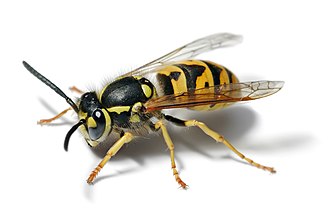Holometabola





Holometabola, also known as Endopterygota, is a significant superorder within the Insecta class, encompassing insects that undergo complete metamorphosis. This developmental process is characterized by four distinct life stages: egg, larva, pupa, and adult. Holometabola includes many of the most familiar insects, such as butterflies, moths, beetles, flies, and wasps.
Characteristics[edit]
The defining feature of Holometabola is the complete metamorphosis life cycle. Unlike hemimetabolous insects, which develop through a series of nymph stages gradually resembling the adult form, holometabolous insects have a larval stage that looks entirely different from the adult. This larval stage is often specialized for feeding and growth, while the adult stage is primarily for reproduction and dispersal. The pupal stage serves as a transition during which the larva undergoes significant reorganization and differentiation to emerge as an adult.
Evolution[edit]
The evolutionary origins of Holometabola are still a subject of research and debate. It is believed that complete metamorphosis has provided evolutionary advantages by reducing competition between the juvenile and adult stages and by enabling specialization in life cycle stages. This evolutionary strategy has led to the vast diversification and ecological success of holometabolous insects. Fossil records indicate that the earliest holometabolous insects appeared in the Carboniferous period, with more definitive evidence from the Permian period.
Taxonomy[edit]
Holometabola is divided into several orders, including but not limited to:
- Coleoptera (beetles)
- Lepidoptera (butterflies and moths)
- Diptera (flies)
- Hymenoptera (wasps, bees, ants, and sawflies)
- Neuroptera (lacewings and their relatives)
- Trichoptera (caddisflies)
- Siphonaptera (fleas)
Each of these orders exhibits a wide range of adaptations and ecological niches, showcasing the versatility and success of the holometabolous life cycle.
Ecological and Economic Importance[edit]
Holometabolous insects play crucial roles in various ecosystems. They act as pollinators, predators, and prey, contributing to the balance of many ecological systems. Additionally, some species are important in agriculture, either as pollinators or as pests. Others, such as certain flies and mosquitoes, are vectors for diseases affecting humans and animals.
Conservation[edit]
While many holometabolous insects are abundant, some species are threatened by habitat loss, pollution, climate change, and other human activities. Conservation efforts are essential to preserve the biodiversity and the ecological services provided by these insects.

Ad. Transform your life with W8MD's Budget GLP-1 injections from $75


W8MD offers a medical weight loss program to lose weight in Philadelphia. Our physician-supervised medical weight loss provides:
- Weight loss injections in NYC (generic and brand names):
- Zepbound / Mounjaro, Wegovy / Ozempic, Saxenda
- Most insurances accepted or discounted self-pay rates. We will obtain insurance prior authorizations if needed.
- Generic GLP1 weight loss injections from $75 for the starting dose.
- Also offer prescription weight loss medications including Phentermine, Qsymia, Diethylpropion, Contrave etc.
NYC weight loss doctor appointmentsNYC weight loss doctor appointments
Start your NYC weight loss journey today at our NYC medical weight loss and Philadelphia medical weight loss clinics.
- Call 718-946-5500 to lose weight in NYC or for medical weight loss in Philadelphia 215-676-2334.
- Tags:NYC medical weight loss, Philadelphia lose weight Zepbound NYC, Budget GLP1 weight loss injections, Wegovy Philadelphia, Wegovy NYC, Philadelphia medical weight loss, Brookly weight loss and Wegovy NYC
|
WikiMD's Wellness Encyclopedia |
| Let Food Be Thy Medicine Medicine Thy Food - Hippocrates |
Medical Disclaimer: WikiMD is not a substitute for professional medical advice. The information on WikiMD is provided as an information resource only, may be incorrect, outdated or misleading, and is not to be used or relied on for any diagnostic or treatment purposes. Please consult your health care provider before making any healthcare decisions or for guidance about a specific medical condition. WikiMD expressly disclaims responsibility, and shall have no liability, for any damages, loss, injury, or liability whatsoever suffered as a result of your reliance on the information contained in this site. By visiting this site you agree to the foregoing terms and conditions, which may from time to time be changed or supplemented by WikiMD. If you do not agree to the foregoing terms and conditions, you should not enter or use this site. See full disclaimer.
Credits:Most images are courtesy of Wikimedia commons, and templates, categories Wikipedia, licensed under CC BY SA or similar.
Translate this page: - East Asian
中文,
日本,
한국어,
South Asian
हिन्दी,
தமிழ்,
తెలుగు,
Urdu,
ಕನ್ನಡ,
Southeast Asian
Indonesian,
Vietnamese,
Thai,
မြန်မာဘာသာ,
বাংলা
European
español,
Deutsch,
français,
Greek,
português do Brasil,
polski,
română,
русский,
Nederlands,
norsk,
svenska,
suomi,
Italian
Middle Eastern & African
عربى,
Turkish,
Persian,
Hebrew,
Afrikaans,
isiZulu,
Kiswahili,
Other
Bulgarian,
Hungarian,
Czech,
Swedish,
മലയാളം,
मराठी,
ਪੰਜਾਬੀ,
ગુજરાતી,
Portuguese,
Ukrainian